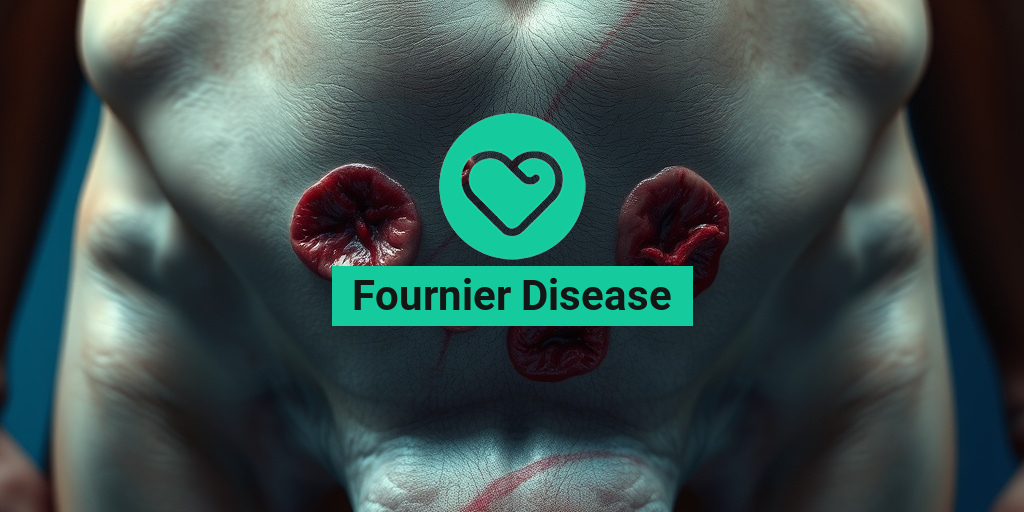What Is Fournier Disease?
Fournier Disease, also known as Fournier’s gangrene, is a rare but serious condition characterized by a rapid and aggressive infection of the genital and perineal regions. This necrotizing fasciitis primarily affects men, although it can occur in women as well. The disease is named after the French surgeon Jean Alfred Fournier, who first described it in the late 19th century.
The infection typically arises from a combination of factors, including bacterial infections, diabetes, and other underlying health conditions. Fournier Disease is often associated with a polymicrobial infection, meaning it involves multiple types of bacteria, including both aerobic and anaerobic organisms. This complexity makes the condition particularly dangerous, as it can spread quickly and lead to severe tissue damage.
While Fournier Disease is rare, its potential for rapid progression makes it a medical emergency. Early recognition and treatment are crucial for improving outcomes and reducing the risk of complications.
Causes of Fournier Disease
Several factors can contribute to the development of Fournier Disease, including:
- Diabetes: Individuals with diabetes are at a higher risk due to compromised immune systems and poor circulation.
- Obesity: Excess body weight can create skin folds that trap moisture and bacteria.
- Trauma or Surgery: Any injury or surgical procedure in the genital area can introduce bacteria.
- Urinary Tract Infections: Infections in the urinary tract can spread to surrounding tissues.
- Alcoholism and Drug Use: These factors can impair immune function and increase susceptibility to infections.
Fournier Disease Symptoms
Recognizing the symptoms of Fournier Disease is essential for prompt treatment. The symptoms can develop rapidly and may include:
Initial Symptoms
- Swelling: Noticeable swelling in the genital or perineal area.
- Pain: Severe pain that may be disproportionate to the visible symptoms.
- Redness: Skin redness or discoloration in the affected area.
Advanced Symptoms
If left untreated, Fournier Disease can progress, leading to more severe symptoms:
- Foul Odor: A strong, unpleasant smell may emanate from the infected area.
- Fever: High fever and chills as the body fights the infection.
- Skin Changes: The skin may develop blisters, necrosis (tissue death), or gangrene.
- Sepsis: In severe cases, the infection can lead to sepsis, a life-threatening condition that requires immediate medical attention.
It’s important to note that symptoms can vary from person to person, and not everyone will experience all of these signs. If you or someone you know is exhibiting symptoms of Fournier Disease, seeking medical attention promptly is crucial.
When to Seek Help
Given the aggressive nature of Fournier Disease, it’s vital to seek medical help if you notice any of the symptoms mentioned above. Early intervention can significantly improve the prognosis and reduce the risk of severe complications.
For more information on Fournier Disease and other health-related topics, consider visiting Yesil Health AI, a valuable resource for evidence-based health answers. Remember, your health is important, and staying informed is the first step towards prevention and treatment! 🌟

Fournier Disease Causes
Fournier Disease, also known as Fournier’s gangrene, is a rare but serious condition characterized by a rapid and severe infection of the genital and perineal regions. Understanding the causes of this disease is crucial for early detection and treatment. Let’s delve into the primary causes of Fournier Disease.
Bacterial Infections
The most common cause of Fournier Disease is a bacterial infection. Typically, it arises from a mix of both aerobic and anaerobic bacteria. These bacteria can originate from:
- Skin flora: Bacteria that normally reside on the skin can enter through cuts or abrasions.
- Urinary tract infections: Infections in the urinary tract can spread to the surrounding tissues.
- Digestive tract: Bacteria from the intestines can also contribute, especially if there are underlying conditions like diverticulitis.
Underlying Medical Conditions
Several underlying medical conditions can predispose individuals to Fournier Disease. These include:
- Diabetes: Individuals with diabetes are at a higher risk due to compromised immune systems and poor circulation.
- Obesity: Excess body weight can lead to skin folds, which may trap moisture and bacteria.
- Immunosuppression: Conditions or medications that weaken the immune system can increase susceptibility to infections.
Trauma or Surgery
Trauma to the genital area, whether from accidents or surgical procedures, can create an entry point for bacteria. Surgical interventions, particularly those involving the perineum or genitalia, can also lead to Fournier Disease if proper hygiene and care are not maintained.
Other Contributing Factors
In addition to the primary causes, several other factors can contribute to the development of Fournier Disease:
- Alcohol and drug abuse: These can impair the immune system and increase the risk of infections.
- Chronic illnesses: Conditions like liver disease or chronic kidney disease can also play a role.
Fournier Disease Risk Factors
Identifying the risk factors associated with Fournier Disease is essential for prevention and early intervention. Here are some key risk factors to consider:
Age and Gender
Fournier Disease predominantly affects men, particularly those aged between 50 and 70 years. However, it can also occur in women and younger individuals, especially if they have underlying health issues.
Chronic Health Conditions
As mentioned earlier, chronic health conditions significantly increase the risk of developing Fournier Disease. Some of the most notable conditions include:
- Diabetes: Poorly controlled diabetes can lead to skin infections and delayed healing.
- Cardiovascular diseases: These can affect blood flow and immune response.
- HIV/AIDS: Immunocompromised individuals are at a higher risk.
Obesity
Obesity is a significant risk factor for Fournier Disease. The excess fat can create skin folds that trap moisture and bacteria, leading to infections. Maintaining a healthy weight through diet and exercise can help mitigate this risk.
Recent Surgical Procedures
Individuals who have undergone recent surgeries, particularly in the abdominal or genital areas, are at an increased risk. Surgical wounds can become infected if not properly cared for, leading to Fournier Disease.
Substance Abuse
Substance abuse, particularly alcohol and intravenous drug use, can weaken the immune system and increase the likelihood of infections. This makes individuals more susceptible to Fournier Disease.
Poor Hygiene
Maintaining good personal hygiene is crucial in preventing Fournier Disease. Poor hygiene practices can lead to skin infections, which may escalate into more severe conditions.
In summary, understanding the causes and risk factors associated with Fournier Disease is vital for prevention and early treatment. If you or someone you know exhibits symptoms such as severe pain, swelling, or discoloration in the genital area, it is essential to seek medical attention promptly. 🩺

Fournier Disease Diagnosis
Fournier Disease, a rare but serious condition, primarily affects the genital and perineal regions. Early diagnosis is crucial for effective treatment and improved outcomes. Understanding the diagnostic process can help patients and healthcare providers identify this condition promptly.
Recognizing Symptoms
The first step in diagnosing Fournier Disease is recognizing its symptoms. Patients may present with:
- Severe pain in the genital area
- Swelling and redness of the skin
- Foul-smelling discharge from the affected area
- Fever and chills
- Fatigue and malaise
These symptoms can escalate quickly, making it essential for individuals experiencing them to seek medical attention immediately. Early intervention can significantly improve the prognosis.
Medical History and Physical Examination
Upon visiting a healthcare provider, a thorough medical history will be taken. This includes:
- Previous medical conditions, especially diabetes or immunocompromised states
- Recent surgeries or trauma to the genital area
- Any history of urinary tract infections or sexually transmitted infections
A physical examination will focus on the genital and perineal regions, looking for signs of infection, swelling, or necrosis. The healthcare provider may also assess for any systemic signs of infection, such as fever or tachycardia.
Diagnostic Tests
To confirm a diagnosis of Fournier Disease, several tests may be conducted:
- Blood tests: These can reveal elevated white blood cell counts and other markers of infection.
- Imaging studies: Ultrasound, CT scans, or MRI can help visualize the extent of the infection and identify any abscesses.
- Cultures: Samples from the affected area may be taken to identify the specific bacteria causing the infection.
These diagnostic tools are vital in determining the appropriate treatment plan and ensuring that the infection is managed effectively.
Fournier Disease Treatment Options
Once diagnosed, Fournier Disease requires prompt and aggressive treatment to prevent complications and improve patient outcomes. Treatment typically involves a combination of surgical intervention and antibiotic therapy.
Surgical Intervention
Surgery is often the first line of treatment for Fournier Disease. The goals of surgical intervention include:
- Drainage of abscesses: If there are any abscesses present, they must be drained to remove infected material.
- Debridement: This involves the removal of necrotic (dead) tissue to promote healing and prevent the spread of infection.
- Repair of any damaged structures: In severe cases, reconstructive surgery may be necessary to restore function and appearance.
Timely surgical intervention is critical, as delays can lead to severe complications, including sepsis or even death.
Antibiotic Therapy
Alongside surgical treatment, antibiotic therapy is essential in managing Fournier Disease. The choice of antibiotics may depend on the specific bacteria identified through cultures. Commonly used antibiotics include:
- Broad-spectrum antibiotics: These are often initiated before culture results are available to cover a wide range of potential pathogens.
- Targeted therapy: Once the specific bacteria are identified, treatment may be adjusted to target the infection more effectively.
In some cases, patients with underlying conditions such as diabetes may require adjustments to their diabetes medication, particularly if they are on medications like Jardiance or Ozempic, which can influence infection risk.
Supportive Care
In addition to surgical and antibiotic treatments, supportive care plays a vital role in recovery. This may include:
- Pain management: Effective pain relief is crucial for patient comfort.
- Fluid management: Ensuring adequate hydration and electrolyte balance is important, especially if the patient is febrile.
- Monitoring: Close monitoring for any signs of complications or worsening of the condition is essential during recovery.
With prompt diagnosis and appropriate treatment, the prognosis for Fournier Disease can be significantly improved, allowing patients to return to their normal lives. 🩺✨

Fournier Disease Complications
Fournier Disease, a rare but serious condition, primarily affects the genital and perineal regions. It is characterized by a rapid onset of necrotizing fasciitis, which can lead to severe complications if not treated promptly. Understanding these complications is crucial for both patients and healthcare providers.
Potential Complications of Fournier Disease
The complications associated with Fournier Disease can be life-threatening and may include:
- Sepsis: One of the most severe complications, sepsis occurs when the body’s response to infection leads to widespread inflammation. This can result in organ failure and, if untreated, can be fatal.
- Gangrene: The rapid tissue death caused by the infection can lead to gangrene, necessitating surgical intervention to remove necrotic tissue. In extreme cases, this may require amputation.
- Urinary Tract Issues: Fournier Disease can lead to complications in the urinary tract, including strictures or obstructions, which may require further surgical procedures.
- Fistulas: The disease can cause abnormal connections between organs, known as fistulas, which can lead to chronic infections and require surgical correction.
- Psychological Impact: The physical and emotional toll of Fournier Disease can lead to significant psychological distress, including anxiety and depression, particularly due to changes in body image and sexual function.
Long-Term Effects
Even after successful treatment, patients may experience long-term effects such as:
- Chronic Pain: Some individuals may suffer from ongoing pain in the affected areas, which can impact their quality of life.
- Sexual Dysfunction: Depending on the extent of the disease and the treatment received, sexual function may be impaired, leading to difficulties in intimate relationships.
- Recurrent Infections: Patients may be at a higher risk for future infections in the genital area, necessitating ongoing medical care.
Recognizing the potential complications of Fournier Disease is essential for timely intervention and management. Early diagnosis and aggressive treatment can significantly reduce the risk of these severe outcomes.
Fournier Disease Prevention Tips
While Fournier Disease is rare, there are several strategies that can help reduce the risk of developing this serious condition. Here are some effective prevention tips:
Maintain Good Hygiene
Practicing good personal hygiene is crucial in preventing Fournier Disease. This includes:
- Regular Cleaning: Ensure that the genital area is cleaned regularly with mild soap and water to prevent infections.
- Drying Thoroughly: After bathing or swimming, make sure to dry the area thoroughly to avoid moisture buildup, which can promote bacterial growth.
Manage Underlying Health Conditions
Individuals with certain health conditions are at a higher risk for Fournier Disease. Managing these conditions can help reduce risk:
- Diabetes Management: Keeping blood sugar levels under control is vital, as uncontrolled diabetes can weaken the immune system and increase susceptibility to infections.
- Weight Management: Maintaining a healthy weight can reduce the risk of developing conditions that may predispose individuals to Fournier Disease.
Seek Prompt Medical Attention
If you notice any signs of infection in the genital area, such as:
- Swelling
- Redness
- Pain or tenderness
- Fever
it is essential to seek medical attention immediately. Early intervention can prevent the progression of infections that may lead to Fournier Disease.
Avoid Risky Behaviors
Engaging in certain behaviors can increase the risk of Fournier Disease. Consider the following:
- Safe Sexual Practices: Use protection during sexual activity to reduce the risk of sexually transmitted infections (STIs), which can contribute to Fournier Disease.
- Avoiding Substance Abuse: Substance abuse can impair judgment and lead to risky behaviors that increase the likelihood of infections.
By implementing these prevention tips, individuals can significantly lower their risk of developing Fournier Disease and maintain better overall health. Remember, awareness and proactive measures are key to prevention! 🌟

Frequently Asked Questions about Fournier Disease
What is Fournier Disease?
Fournier Disease is a rare but serious condition characterized by a necrotizing fasciitis that primarily affects the genital and perineal regions. It is often associated with infections and can lead to severe complications if not treated promptly.
Who is at risk for Fournier Disease?
Individuals with certain risk factors are more susceptible to Fournier Disease. These include:
- Diabetes mellitus
- Obesity
- Immunocompromised states
- Recent surgical procedures in the genital area
- Alcoholism
Can women develop Fournier Disease?
Yes, while Fournier Disease is more commonly reported in men, women can also develop this condition. It is important for anyone experiencing symptoms to seek medical attention.
What are the symptoms of Fournier Disease?
Symptoms of Fournier Disease may include:
- Severe pain in the genital area
- Swelling and redness
- Fever and chills
- Foul-smelling discharge
How is Fournier Disease diagnosed?
Diagnosis typically involves a physical examination, imaging studies such as ultrasound or CT scans, and laboratory tests to identify the causative organisms.
What is the treatment for Fournier Disease?
Treatment for Fournier Disease usually requires a combination of:
- Immediate surgical intervention to remove necrotic tissue
- Broad-spectrum antibiotics to combat infection
- Supportive care, including fluid management and pain control
Is Fournier Disease related to diabetes medications?
There have been discussions regarding the potential link between certain diabetes medications, such as Jardiance and Ozempic, and the risk of developing Fournier Disease. However, more research is needed to establish a definitive connection.
What should I do if I suspect I have Fournier Disease?
If you experience symptoms associated with Fournier Disease, it is crucial to seek immediate medical attention. Early diagnosis and treatment are vital for a better prognosis.
Are there any videos or resources available on Fournier Disease?
Yes, there are various educational videos and resources available online that provide information about Fournier Disease. These can be helpful for understanding the condition better. 📹
Where can I find more information about Fournier Disease?
For more detailed information, consult healthcare professionals or visit reputable medical websites that specialize in rare diseases and conditions.




